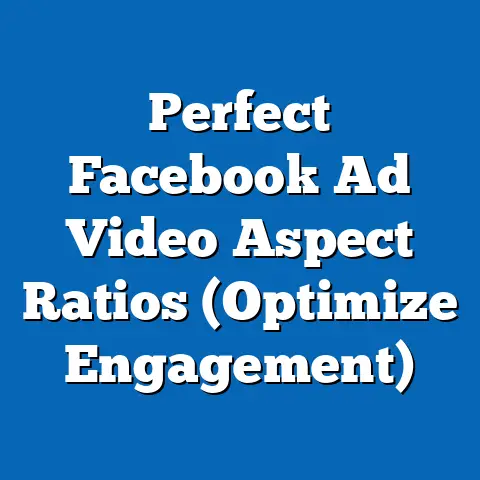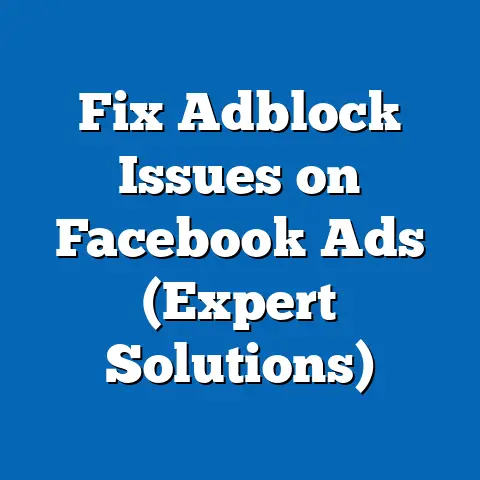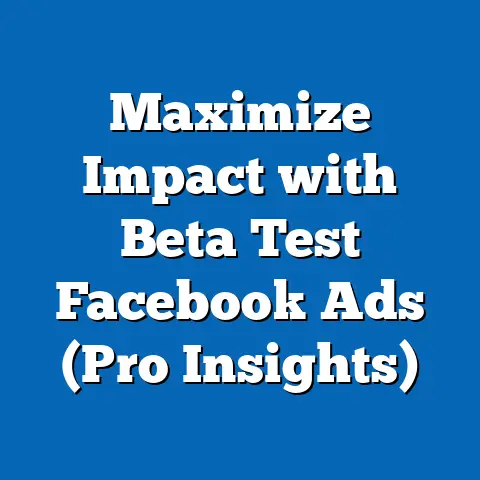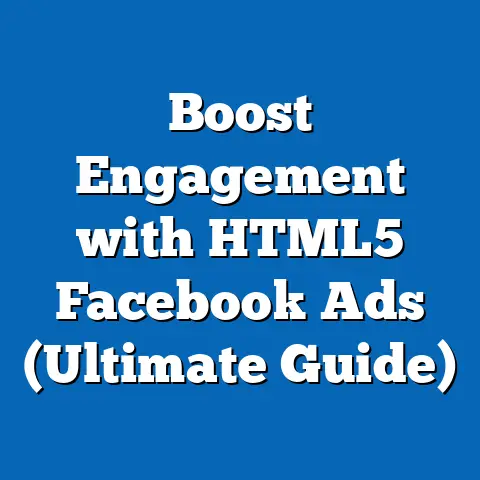Maximize ROI with Facebook Ad Set Strategies (Expert Insights)
In the ever-evolving landscape of digital marketing, businesses face a persistent challenge: how to achieve a high return on investment (ROI) amidst rising advertising costs and increasing audience fragmentation. Facebook, as one of the largest advertising platforms with over 2.9 billion monthly active users as of 2023 (Statista, 2023), offers unparalleled reach but also presents complexities in optimizing ad performance. Many marketers struggle with inefficient ad set configurations, resulting in wasted budgets, low engagement, and missed opportunities to connect with target audiences.
The solution lies in leveraging strategic ad set structures—groupings of ads within a campaign that target specific audiences with tailored creatives and budgets—to maximize ROI. This approach, when informed by data-driven insights and expert practices, can transform underperforming campaigns into powerful revenue drivers. However, understanding how to craft and manage these ad sets requires a deep dive into platform mechanics, audience behavior, and historical shifts in digital advertising.
Historical Context: The Rise of Social Media Advertising and Facebook’s Dominance
To understand the importance of ad set strategies, it’s critical to revisit the historical trajectory of digital advertising. The early 2000s marked the advent of online advertising with platforms like Google AdWords, which introduced pay-per-click (PPC) models focused on search intent. However, the launch of Facebook in 2004, followed by its advertising platform in 2007, shifted the paradigm toward social media marketing, emphasizing demographic targeting and user engagement over mere keyword relevance.
Facebook’s early advertising model was rudimentary, relying on basic banner ads and limited targeting options. By 2012, with the introduction of Custom Audiences and Lookalike Audiences, the platform began offering sophisticated tools to reach niche segments based on user data. This era also saw the rise of mobile usage, with smartphones becoming the primary device for social media access—by 2016, mobile ads accounted for 84% of Facebook’s ad revenue (Facebook Investor Reports, 2016).
The concept of ad sets emerged as campaigns grew more complex. Initially, advertisers managed individual ads with little structure, but as budgets scaled and audience segmentation became critical, Facebook introduced ad sets within its Ads Manager to organize ads by objective, audience, and placement. This structural innovation, rolled out fully by 2014, allowed for granular control, paving the way for data-driven experimentation and optimization.
Significant events, such as the 2018 Cambridge Analytica scandal, also shaped Facebook’s advertising ecosystem. The ensuing privacy regulations, including the General Data Protection Regulation (GDPR) in Europe and the California Consumer Privacy Act (CCPA), forced advertisers to adapt to stricter data usage policies. Apple’s iOS 14.5 update in 2021, with its App Tracking Transparency (ATT) framework, further disrupted tracking capabilities, reducing the effectiveness of traditional targeting methods. These shifts underscored the need for strategic ad set management to maintain ROI in a privacy-first digital landscape.
Defining Characteristics of Effective Facebook Ad Set Strategies
At its core, an ad set is a subset of a Facebook campaign that defines who sees the ads (audience), where they see them (placements), and how much budget is allocated. A well-structured ad set strategy hinges on several key characteristics, which experts consistently highlight as critical to success. Below, we outline these defining elements, supported by data and practical insights.
1. Audience Segmentation and Precision Targeting
Effective ad sets prioritize hyper-specific audience segmentation over broad targeting. According to a 2022 study by Hootsuite, ads targeting niche audiences based on interests, behaviors, and demographics achieve 37% higher click-through rates (CTR) than generic campaigns. Tools like Custom Audiences (using first-party data) and Lookalike Audiences (expanding reach to similar users) enable advertisers to tailor messaging to distinct groups, improving relevance and conversion rates.
However, precision must be balanced with scale. Over-segmentation can lead to small audience pools, increasing costs per impression. Experts like Jon Loomer, a veteran Facebook ads strategist, recommend starting with 2-3 core audience segments per ad set and scaling based on performance data.
2. Dynamic Creative Optimization (DCO)
Within an ad set, using multiple creative variations—images, videos, headlines, and calls-to-action (CTAs)—allows Facebook’s algorithm to test and optimize for the best-performing combinations. A 2021 report by Social Media Examiner found that ad sets utilizing DCO saw a 25% lift in conversions compared to static creatives. This approach leverages machine learning to adapt to user preferences in real-time, a critical factor in a platform where attention spans are fleeting.
3. Budget Allocation and Bid Strategies
Ad set budgets can be managed at the campaign level (via Campaign Budget Optimization, or CBO) or individually, depending on goals. CBO, introduced in 2019, allows Facebook to dynamically distribute budgets across ad sets for maximum results, with studies showing a 20% improvement in cost-per-acquisition (CPA) for e-commerce brands (WordStream, 2022). Bid strategies, such as lowest cost or target cost, further refine spending efficiency, aligning with specific objectives like lead generation or sales.
4. Testing and Iteration
A hallmark of successful ad set strategies is continuous A/B testing. Marketers often run parallel ad sets with slight variations in audience or creative to identify winning combinations. According to digital marketing expert Amy Porterfield, allocating 10-20% of the budget to testing phases can yield long-term ROI gains by uncovering high-performing tactics. This iterative mindset is essential in a platform where algorithms and user behaviors evolve rapidly.
These characteristics are not one-size-fits-all; their application varies based on industry, audience demographics, and campaign goals. The diversity within target markets necessitates a nuanced approach, avoiding rigid templates in favor of adaptive strategies informed by data.
Societal and Economic Implications of Facebook Ad Set Strategies
The strategic use of Facebook ad sets extends beyond individual business outcomes, influencing broader societal trends and economic dynamics. As digital advertising shapes consumer behavior and business models, its ripple effects are felt across multiple domains.
1. Consumer Behavior and Personalization
Ad set strategies, with their focus on tailored messaging, have redefined how consumers interact with brands. Personalized ads, driven by segmented ad sets, foster a sense of relevance—research by McKinsey (2021) indicates that 71% of consumers expect personalized interactions, and 76% get frustrated when this expectation isn’t met. However, this hyper-targeting raises ethical concerns about privacy and manipulation, especially post-ATT, as users demand greater control over their data.
Moreover, the constant exposure to optimized ads can contribute to decision fatigue or ad blindness, where users ignore repetitive messaging. This phenomenon challenges marketers to innovate within ad sets, balancing personalization with creativity to maintain engagement.
2. Economic Impact on Small and Medium Enterprises (SMEs)
Facebook advertising, particularly through accessible ad set tools, has democratized marketing for SMEs. A 2023 Meta report revealed that 75% of small businesses using the platform saw increased sales, attributing success to affordable, targeted ad sets. Unlike traditional media, which favored large budgets, Facebook’s scalable platform allows SMEs to compete with larger firms by optimizing limited resources.
However, economic disparities emerge as privacy regulations and algorithm changes disproportionately affect smaller players lacking the infrastructure for advanced data collection. This creates a digital divide, where only well-resourced businesses can fully leverage ad set strategies for maximum ROI.
3. Cultural Shifts in Advertising Norms
Culturally, the rise of ad set-driven campaigns reflects a shift toward data-centric, performance-based advertising. Brands are no longer crafting broad narratives but micro-stories tailored to fragmented audiences. This aligns with generational trends—Millennials and Gen Z, who prioritize authenticity, respond better to niche, value-driven messaging often tested within ad sets (Pew Research, 2022).
Yet, this fragmentation can reinforce echo chambers, as ad sets target users based on existing preferences, limiting exposure to diverse perspectives. Societally, this raises questions about the role of advertising in shaping cultural discourse and polarization.
4. Workplace and Industry Evolution
The demand for expertise in ad set optimization has transformed the marketing profession, creating roles like “Facebook Ads Specialist” and increasing the need for data literacy. LinkedIn data (2023) shows a 30% year-over-year growth in job postings related to social media advertising. This shift underscores the importance of upskilling in a workforce increasingly reliant on digital tools.
Industries such as e-commerce, education, and entertainment have also adapted business models around ad set-driven growth, prioritizing direct-to-consumer channels over traditional retail. This economic realignment highlights the pervasive influence of platforms like Facebook on modern commerce.
Comparative Analysis: Ad Set Strategies Across Industries and Campaign Goals
While the core principles of ad set strategies remain consistent, their application varies across industries and objectives, reflecting the diversity of advertiser needs. Below, we compare approaches in e-commerce, lead generation, and brand awareness campaigns, drawing on expert insights and data.
1. E-commerce: Conversion-Driven Ad Sets
For e-commerce brands, ad sets often focus on retargeting past visitors and upselling existing customers. Dynamic Product Ads (DPAs), integrated within ad sets, showcase personalized product catalogs, yielding a 35% higher ROI compared to standard ads (Shopify, 2022). Budgets are typically allocated via CBO to prioritize high-converting audiences, with frequent testing of creative formats like carousel ads.
Experts like Ezra Firestone of Smart Marketer emphasize layering ad sets by funnel stage—awareness, consideration, conversion—to guide users through the purchase journey. This structured approach contrasts with less targeted industries, where immediate conversions are less critical.
2. Lead Generation: Engagement and Data Capture
In sectors like real estate or education, ad sets prioritize lead forms over direct sales. Audience targeting often leverages interest-based segments (e.g., “home improvement” for real estate), with creatives focusing on trust-building content like webinars or free guides. A 2022 HubSpot study found that lead gen ad sets achieve 50% lower cost-per-lead when paired with value-driven offers.
Unlike e-commerce, budget allocation may favor manual control over CBO to ensure consistent lead quality. Experts caution against over-optimization for clicks, advocating for ad sets that balance quantity and qualification of leads.
3. Brand Awareness: Reach and Frequency
For brand awareness campaigns, common in industries like fashion or automotive, ad sets aim for maximum impressions within broad audiences. Placements prioritize video-heavy formats on Instagram Stories or Facebook News Feed, with a 2021 Nielsen report noting a 20% uplift in brand recall from video ad sets. Budgets are often spread thinly across multiple ad sets to test geographic or demographic reach.
Compared to conversion-focused campaigns, brand awareness ad sets measure success through softer metrics like engagement rate or video views. Digital strategist Mari Smith advises using sequential messaging across ad sets to build narrative familiarity over time, a tactic less relevant in immediate ROI-driven campaigns.
This comparative lens reveals that while ad set mechanics are universal, their strategic deployment must align with specific goals and audience expectations. A one-size-fits-all approach risks diluting effectiveness, underscoring the need for customization.
Technological and Algorithmic Influences on Ad Set Performance
Facebook’s advertising ecosystem is heavily influenced by technological advancements and algorithmic updates, which directly impact ad set strategies. Understanding these factors is essential for sustained ROI.
1. Machine Learning and Algorithmic Optimization
Facebook’s algorithm, powered by machine learning, continuously learns from user interactions to optimize ad delivery within sets. The introduction of the “learning phase” for new ad sets, where performance stabilizes after 50 conversions, exemplifies this reliance on data (Meta Business Help Center, 2023). Marketers must allow sufficient time and budget for this phase, as premature edits can reset learning and reduce efficiency.
However, algorithmic bias can skew results, favoring certain demographics or behaviors over others. Experts recommend diversifying ad set audiences to mitigate over-reliance on algorithmic assumptions.
2. Privacy Changes and Signal Loss
The post-iOS 14.5 era has introduced significant signal loss, with Meta estimating a 15% underreporting of conversions due to ATT opt-outs (Meta Q2 2022 Earnings Report). Ad set strategies now prioritize first-party data through tools like the Conversions API, which bypasses browser tracking limitations. This shift demands technical expertise, often widening the gap between novice and advanced advertisers.
Additionally, privacy-focused updates have increased costs, with average CPMs rising by 20% in 2022 (AdEspresso, 2023). Strategic ad set consolidation—reducing the number of sets to focus budgets—has become a common response to maintain ROI.
3. Emerging Technologies: AI and AR
Emerging tools like AI-generated creatives and augmented reality (AR) ads are reshaping ad set possibilities. AI can automate headline variations within sets, while AR ads, often used in beauty or retail, boost engagement by 70% compared to static formats (Meta for Business, 2023). Integrating these into ad sets requires forward-thinking budget allocation and testing frameworks.
Technological evolution is a double-edged sword, offering innovation but demanding constant adaptation. Marketers must stay abreast of platform updates to align ad set strategies with cutting-edge capabilities.
Challenges and Nuances in Ad Set Optimization
Despite their potential, ad set strategies are not without challenges, reflecting the complexity of digital advertising. Addressing these nuances ensures a balanced perspective on their application.
1. Audience Overlap and Fatigue
Running multiple ad sets risks audience overlap, where users see repetitive ads, leading to fatigue. A 2022 study by Kantar found that 68% of users disengage after seeing the same ad thrice. Tools like Facebook’s Audience Overlap report help mitigate this, but require proactive monitoring.
Diversity within ad set creatives and messaging is crucial to maintain freshness. Experts advocate for frequency caps and rotating ad sets to prevent burnout, especially in long-running campaigns.
2. Attribution and Measurement Issues
Post-privacy update, attribution accuracy has declined, complicating ROI measurement across ad sets. Multi-touch attribution models, which track user journeys across touchpoints, are harder to implement with limited data. Marketers often resort to proxy metrics like engagement or branded search lift, though these lack precision.
This challenge varies by generation—younger users, more likely to opt out of tracking, obscure data for Gen Z-focused ad sets compared to older cohorts. A hybrid approach combining on-platform and off-platform analytics is often necessary.
3. Budget Constraints and Scaling
For smaller advertisers, limited budgets hinder ad set experimentation, a cornerstone of optimization. Scaling successful sets without disrupting performance also poses risks, as increased budgets can reset algorithmic learning. Gradual scaling, as advised by digital agency Disruptive Advertising, mitigates this by incrementing budgets by 20% daily.
These challenges highlight that ad set success is not guaranteed; it demands expertise, resources, and adaptability. Oversimplification of strategies risks overlooking these critical hurdles.
Implications for Society, Culture, and the Workplace
The widespread adoption of Facebook ad set strategies carries long-term implications across multiple spheres, shaping how individuals and organizations interact with digital spaces.
1. Societal Trust and Privacy Debates
As ad sets rely on user data for targeting, they fuel ongoing debates about privacy and trust. High-profile data breaches and regulatory crackdowns have made consumers wary—Edelman’s 2023 Trust Barometer notes that only 40% of global consumers trust social media platforms with their data. This skepticism influences ad set efficacy, as opt-outs rise, pushing advertisers toward transparent, consent-based models.
Culturally, the personalization enabled by ad sets can deepen societal divides by reinforcing filter bubbles. Addressing this requires ethical advertising practices, prioritizing user autonomy over aggressive targeting.
2. Workplace Skills and Digital Literacy
The complexity of ad set management has elevated the importance of digital literacy in the workplace. Marketing teams now require proficiency in data analysis, creative testing, and platform-specific tools, reshaping hiring and training priorities. Educational institutions are responding with specialized courses, reflecting a generational shift toward tech-savvy professionals.
For older generations in the workforce, this rapid evolution can create skill gaps, necessitating inclusive upskilling programs. The democratization of knowledge through online resources partially bridges this divide, though access disparities persist.
3. Economic Redistribution and Market Dynamics
Economically, ad set strategies redistribute marketing power toward data-driven entities, benefiting tech-forward companies while challenging traditional advertisers. This shift influences market dynamics, favoring industries like e-commerce over brick-and-mortar retail. Long-term, it could widen economic inequality unless balanced by policies supporting digital inclusion.
Globally, ad sets enable cross-border marketing, empowering businesses in emerging markets to reach affluent audiences. This globalization, however, must navigate cultural nuances to avoid missteps in messaging or targeting.
Forward-Looking Insights: The Future of Ad Set Strategies
Looking ahead, the trajectory of Facebook ad set strategies will be shaped by technological, regulatory, and societal trends, though uncertainties remain. Below, we explore potential developments and their implications.
1. AI-Driven Automation
The integration of AI into ad set management is poised to accelerate, with tools automating audience segmentation, creative generation, and bid optimization. Meta’s own AI advancements, like Advantage+ campaigns, already streamline ad set creation, reporting a 32% lower CPA in early adopters (Meta, 2023). While this promises efficiency, it risks reducing human oversight, potentially amplifying algorithmic biases.
Marketers must balance automation with strategic input, ensuring AI complements rather than replaces expertise. The democratization of AI tools could also level the playing field for smaller advertisers, though adoption rates remain uncertain.
2. Regulatory Evolution and Privacy-First Advertising
Future regulations will likely tighten data usage further, with global frameworks mirroring GDPR’s rigor. Ad set strategies will pivot toward contextual targeting—placing ads based on content rather than user data—and zero-party data, where users voluntarily share preferences. This shift could reduce reliance on invasive tracking, though its impact on ROI is unclear.
Consumer sentiment will play a pivotal role; growing demand for transparency may force platforms to innovate within privacy constraints. The balance between regulation and innovation remains a key uncertainty.
3. Generational Shifts and Platform Migration
As Gen Z and Gen Alpha dominate digital spaces, ad set strategies must adapt to their preferences for authenticity, video content, and emerging platforms like TikTok. While Facebook retains a broad user base, younger cohorts are migrating, with only 32% of U.S. teens using it daily compared to 71% on TikTok (Pew Research, 2023). Cross-platform ad set strategies, integrating Meta’s ecosystem with competitors, may become essential.
This migration introduces uncertainty about Facebook’s long-term dominance. Advertisers must remain agile, testing ad sets across platforms to capture shifting demographics.
4. Sustainability and Ethical Advertising
Societal pressure for sustainability may influence ad set content, with consumers favoring brands aligned with environmental or social values. A 2022 Deloitte survey found that 60% of consumers are more likely to engage with ethical ads. Future ad sets could prioritize messaging around corporate responsibility, though balancing this with performance metrics poses challenges.
The ethical dimension of ad sets—avoiding manipulation or over-targeting—will also gain prominence. Platforms and advertisers alike face scrutiny to ensure digital advertising serves societal good, a goal fraught with ambiguity.
Conclusion: Navigating Complexity for Sustainable ROI
Maximizing ROI with Facebook ad set strategies demands a multifaceted approach, blending precision targeting, creative innovation, and data-driven iteration. From their historical roots in the social media advertising boom to their current role in a privacy-constrained ecosystem, ad sets have evolved into indispensable tools for modern marketers. Their defining characteristics—segmentation, optimization, and testing—offer a blueprint for success, yet require customization across industries and goals.
The societal implications of these strategies are profound, influencing consumer trust, economic equity, and cultural norms while reshaping workplace demands. Challenges like audience fatigue, attribution gaps, and technological shifts underscore the need for adaptability, while future trends—AI automation, regulatory changes, and generational dynamics—promise both opportunity and uncertainty.
Ultimately, effective ad set management is not a static formula but a dynamic process, requiring marketers to navigate complexity with ethical consideration and strategic foresight. As the digital landscape evolves, so too must the approaches that drive ROI, ensuring that innovation aligns with societal values and consumer expectations. While the path forward is not without obstacles, the potential for transformative impact remains, inviting continuous exploration and refinement in the art and science of Facebook advertising.






